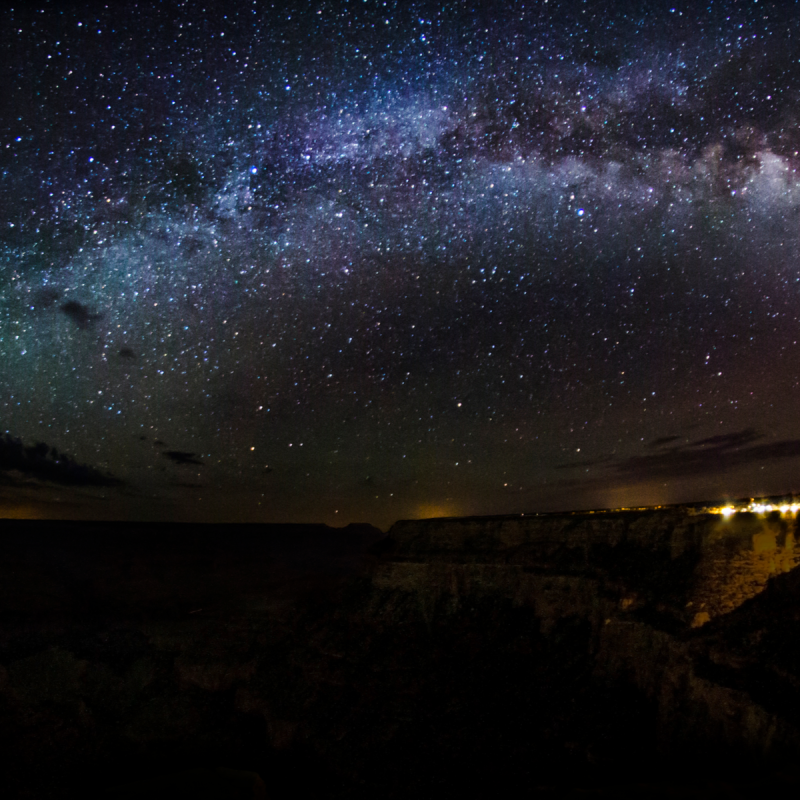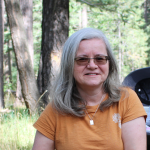
(Photo Credit: BlueBarronPhoto / Shutterstock.com)
With its cloudless, clear skies and low humidity year-round, Arizona is one of the top places in the world for stargazing. The mild night-time weather adds to its allure for the activity. In the summer, as hot as it is during the day, temperatures drop after dark, and in the winter it is much more comfortable than in colder environments.
Videos by TravelAwaits
This combination of clear skies, perfect night-time temperatures, and a landscape with long stretches of empty places makes Arizona the astrotourism capital of the U.S. In fact, Arizona helped start the dark-sky preservation movement when Flagstaff was named the world’s first Dark Sky Place in 2001. Dark Sky Places include communities, parks, and sanctuaries.
Dark Sky Communities are towns that prove their commitment to keeping their light pollution to a minimum. Arizona has six of the total sixteen in the country, including Sedona, the Village of Oak Creek, Camp Verde, and Fountain Hills.
Though you can view the stars in these communities, it is the Dark Sky Parks that offer the most spectacular stargazing opportunities in Arizona. With no light pollution for miles, you have clear views of the stars and constellations. The following are some of the best stargazing spots in Arizona.

(Photo Credit: Alexey Suloev / Shutterstock.com)
1. Grand Canyon National Park
One of the seven natural wonders of the world, the Grand Canyon is the most famous landmark of Arizona, visited by millions each year. The spectacular landscape showcasing different rock layers, the thousands of formations, and the canyon’s sheer size will leave you in awe.
You need to fight crowds to visit the South Rim, but it’s easy to access and offers plenty to do. If you prefer a more remote site, you’ll find a quieter environment at the North Rim, though it involves more driving to get there.
As gorgeous as the Canyon is during the day, its night sky is just as spectacular. Stay overnight and walk out into the dark to enjoy the crisp air and the dark skies. You can camp at the South Rim or stay in a hotel there. The North Rim offers cabins, but you need to book well in advance.
Visit in June for opportunities to attend the annual Grand Canyon Star Party to learn about the constellations you see. Hosted by astronomy clubs from different parts of the state, the star party lasts eight days and includes slide shows, constellation tours, and telescope viewing. You can catch the party on both rims.
2. Sunset Crater Volcano National Monument
One of the best places to enjoy the night sky in Arizona is Sunset Crater Volcano National Monument, and the easiest way to do this is to camp at the Bonito Campground. The otherworldly landscape of the volcanic fields offers lots of daytime hiking opportunities through lava and cinder.
After dark, look up into the clear sky. With Flagstaff’s city lights far in the distance — and dimmer than most other towns its size — the darkness is complete, offering a backdrop to some of the best views of planets, stars, and constellations. On a moonless night, you’ll see the Milky Way stretched across the sky.
Astronomy clubs from Flagstaff, or staff from the Lowell Observatory, offer star viewing events occasionally. If you are there at the right time, stop by to look through telescopes of different sizes, and listen to the astronomers explain the objects in the sky you are looking at.
The campground is only open in the summer, but you can always stay in Flagstaff overnight and drive out to Sunset Crater.
Editor’s Note: The National Park Service announced on August 18, 2022 that the Sunset Crater Volcano is partially open with limited services following the Tunnel Wildfire destruction. The Lava Flow and A’a trails are open. The Visitor Center, Lenox Crater and Lava’s Edge Trails, as well as the Cinder Hills Overlook remain closed. For the most up-to-date information, please visit NPS.gov.
(Photo Credit: Beth Ruggiero-York / Shutterstock.com)
3. Wupatki National Monument
While you are at Sunset Crater, drive farther on the same road, and stop at any of the ruins of Wupatki National Monument to watch the night sky above the ancient buildings.
Rock walls of the ancient people dot the landscape here, offering opportunities to explore them and learn about their inhabitants during the day. At nightfall, they offer a gorgeous backdrop for stargazing.
4. Walnut Canyon National Monument
Still in the vicinity of Flagstaff, you can drive out to Walnut Canyon National Monument, another Dark Sky Park in the area. Visit the cliff dwellings during the day by taking the vertical Island Trail, with opportunities to walk through some of the dwellings. Or take the Rim Trail for a more leisurely walk.
The park has no camping sites and closes at night, which means the visitor center and the Island Trail are not open, but you can still drive in and stay till dark to watch the night sky from the rim.
5. Petrified Forest National Park
In the middle of the colorful Painted Desert, far from civilization, you’ll find Petrified Forest National Park, home to thousands of ancient pieces of petrified wood. Once a lush rainforest, the area is now an eroded desert showcasing the colors of the rainbow. In some areas, it is filled with petrified tree trunks and fossilized animal bones from millions of years ago. All of this is intermixed with a few ancient structures and petroglyphs left behind by the human inhabitants of the area. It is one of the best Dark Sky Places in the state.
The best way to enjoy stargazing here is to camp in the park. The backcountry campgrounds are both about a mile’s walk from the parking lots. You need a permit to camp, and you can get one from one of the visitor centers. Or you can camp in the parking lots of one of the gift shops just outside the south entrance to the park, as long as you are self-contained.
If you are not a camper, you can still enjoy stargazing at Petrified Forest, but you’d need to drive to it from Holbrook, the closest town with a hotel.

(Photo Credit: Zack Frank / Shutterstock.com)
6. Tonto National Monument
Nestled in a dark corner of Arizona along Lake Roosevelt, Tonto National Monument showcases ancient ruins of the Salado people. During the day, visit the lower cliff dwellings and take a guided tour led by a ranger to the higher ones.
Stay in the campground by the ruins for an overnight stargazing experience you’ll never forget. Walk out late at night into the pitch dark to watch the dark skies filled with millions of stars and constellations.
7. Kartchner Caverns State Park
Host to a world-class living limestone cave, Kartchner Caverns State Park offers tours for visitors to enter and enjoy unique formations underground. Two separate tours take you to different parts of the cave, and a discovery center at the entrance explains everything you might want to learn about caves, especially living caves.
Above ground, since it is far from any cities, you can take a hike in the desolate Sonoran Desert, while at night you have an opportunity to enjoy some of the darkest skies. Campgrounds and cabins are both available at the park. You can spend the night and walk out after dark to enjoy the views of the stunning night sky.
8. Oracle State Park
A wildlife refuge at the foothills of the Catalina Mountains in southern Arizona, Oracle State Park offers day-use picnic areas and over 15 miles of trails for hiking, mountain biking, and horseback riding.
Far enough from light pollution to make the Milky Way visible, the park is another exceptional place to watch the night skies. Though you can’t stay in the park overnight, its American Avenue parking area is available after dark.
The park is an hour away from Tucson, where you have plenty of opportunities to stay the night, but if you want to stay closer, you have a few opportunities in Oracle: a guest ranch, a bed and breakfast, and a small hotel.

(Photo Credit: Peter Bowman / Shutterstock.com)
9. Tumacacori National Historical Park
Preserving the remains of three Spanish missions and the surrounding area, Tumacacori National Historical Park offers a visit to the missions and paved trails through the grounds. The park stands at the crossroads of many different cultures. Visiting the park is a great opportunity to learn how the O’odham, Apache, and Yaqui people lived alongside the missionaries, settlers, and soldiers. Learn about their cooperation and their conflict.
The park offers evening programs that draw attention to the night sky as a cultural resource. Watch the dark, star-filled skies and learn about the way the different cultures in the area interpreted it.
Arizona Observatories And Planetariums
Some of the best places for stargazing are observatories and planetariums, and Arizona is home to a few world-class facilities.
Founded in 1894, home to the telescope used to discover Pluto, the Lowell Observatory in Flagstaff offers tours, interactive presentations, and opportunities for stargazing through their telescopes.
Featuring the largest telescope in Arizona dedicated to public viewing, the Mt. Lemmon Sky Center Observatory has a popular after-dark viewing program.
Home to the largest collection of optical and radio telescopes in the world, Kitt Peak National Observatory is a research facility, but it is also open for visitors for guided tours.
Note: Due to COVID restrictions, Kitt Peak and the road leading to it is temporarily closed for visitors. All other observatories in the state offer limited access, and only socially distanced activities.
Best Practices For Stargazing
When stargazing, you need to give your eyes time to adjust to the dark, which takes about twenty minutes. Once your eyes are adjusted, you’ll be amazed at how much you see in a dark sky. You’ll notice differences in brightness and colors of the stars; you’ll recognize patterns and constellations.
Turn all your light sources off and don’t use your phone while waiting, since the light of its screen will ruin your night vision. If you need a light to see where you’re going, use a flashlight with a red filter on. You can buy one with a filter, or do this yourself, by putting a piece of red filter paper under its lens. If you attend a star party, the astronomers will show you how, or offer you one with a filter.
Related Reading:
- 16 Best Hikes To Experience In Arizona
- 5 Reasons Flagstaff, Arizona Is Perfect For Stargazing
- Here’s How To Visit The Wave In Coyote Buttes For A Perfect Photo
- 12 Beautiful Outdoor Experiences In Arizona In Every Season
- 9 Unique Stops From Sedona To The Grand Canyon
- Our 8 Favorite Places For Stargazing In The U.S.
